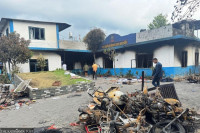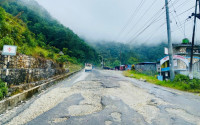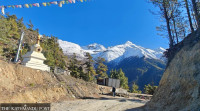Gandaki Province
Manaslu foot trail fraught with dangers
Loose boulders rolling down the Yarubhir in Dharche-1 are becoming a major cause of frequent accidents.
Hariram Upreti
Pulsing Gurung was hit by a boulder that came rolling down Yarubhir along the Manaslu foot trail in Gorkha last Friday morning. Gurung, who is 33, was airlifted to the National Trauma Centre in Kathmandu for treatment but succumbed to his injuries during the course of the treatment.
Gurung was returning from Chumnubri Rural Municipality ward 3 after delivering food items and daily essentials to the villages. “He had injuries on his head, arms and legs,” said Bishal Himali Ghale, a local man. “Gurung owned mules and used to deliver goods to Chhekampar and Chumchet villages in Chumnubri.”
Loose boulders rolling down the Yarubhir in Dharche-1 are becoming a major cause of accidents along the foot trail. Traders, mule owners and the villagers are having a hard time trying to save themselves from being crushed while on their way to the villages.
Two accidents have been reported in the last one and half months along the foot trail. On June 19, Maila Gurung went missing in the Yaru river while trying to rescue his mule out of the roaring river. Several incidents are reported during the monsoon season when the Budhigandaki river and its tributaries flood. From being crushed by boulders to being swept away by the strong current in the river, the locals of the area suffer yearly.
The approach way to a 195-metre-long cantilever bridge, constructed by drilling the rocky cliff of Yaru bhir with the support of the UK Department for International Development in 2016, was washed away by floods in the Budhigandaki river during last year’s rainy season.
Floods in the Budhigandaki river had swept away around 100 metres of the foot trail on the southern side of the bridge. Since then, mule owners and villagers from Chhekampar and Chumchet villages, have been risking their lives to cross the river and dodge falling boulders.
“Boulders falling onto the banks of the river is a common occurrence during the rainy season,” said Surya Gurung, a mule owner who uses the foot trail regularly. “We can’t stop walking through the foot trail because there is no other route to get to Chumnubri villages where I mostly trade. If there was a proper bridge here, we wouldn’t have to walk along the banks of the river and risk getting swept away. We either have to cross the river and risk being swept away or walk along the river banks and get crushed by boulders rolling downhill.”
According to him, the Manaslu foot trail is fraught with danger during the rainy season. “Come monsoon and the risk of accidents along the foot trail increase,” he said. “Loose boulders on the Yarebhir pose a threat to those walking along the banks of the Yare river.”
On April 27, 35-year-old Jeet Bahadur Gurung of Dharche-4 was crushed by a boulder while installing a gabion wall along the banks of Machha Khola. He was taken to the primary health centre for treatment and was referred to a hospital in Kathmandu where he died during the course of his treatment on May 15.
Chumnubri Rural Municipality is not connected to road networks, so the locals rely on the foot trails to commute to and from the villages. Currently, a landslide at Chumchet in the rural municipality’s ward 4 has blocked the foot trail. “The villagers have been unable to venture out of the villages because of landslides. Those on emergency calls have been making their way through the landslide-prone areas across Lokpabhir,” said Sherap Gurung, a local man. “Travelling is very risky in that area since landslides bring huge boulders down the hill.”
During the dry months, vehicles reach up to Dovan through the Larke road stretch. But the monsoon rains have caused disruptions and halted all transportation along the road stretch.
“Walking along the Soti-Machhakhola road stretch is also fraught with dangers with loose boulders tumbling down the hill,” said Sabin Thapa, a local of Deurali. “One has to clear landslide debris and make their way ahead. This has become a perennial problem for us.”




 12.12°C Kathmandu
12.12°C Kathmandu.jpg)










